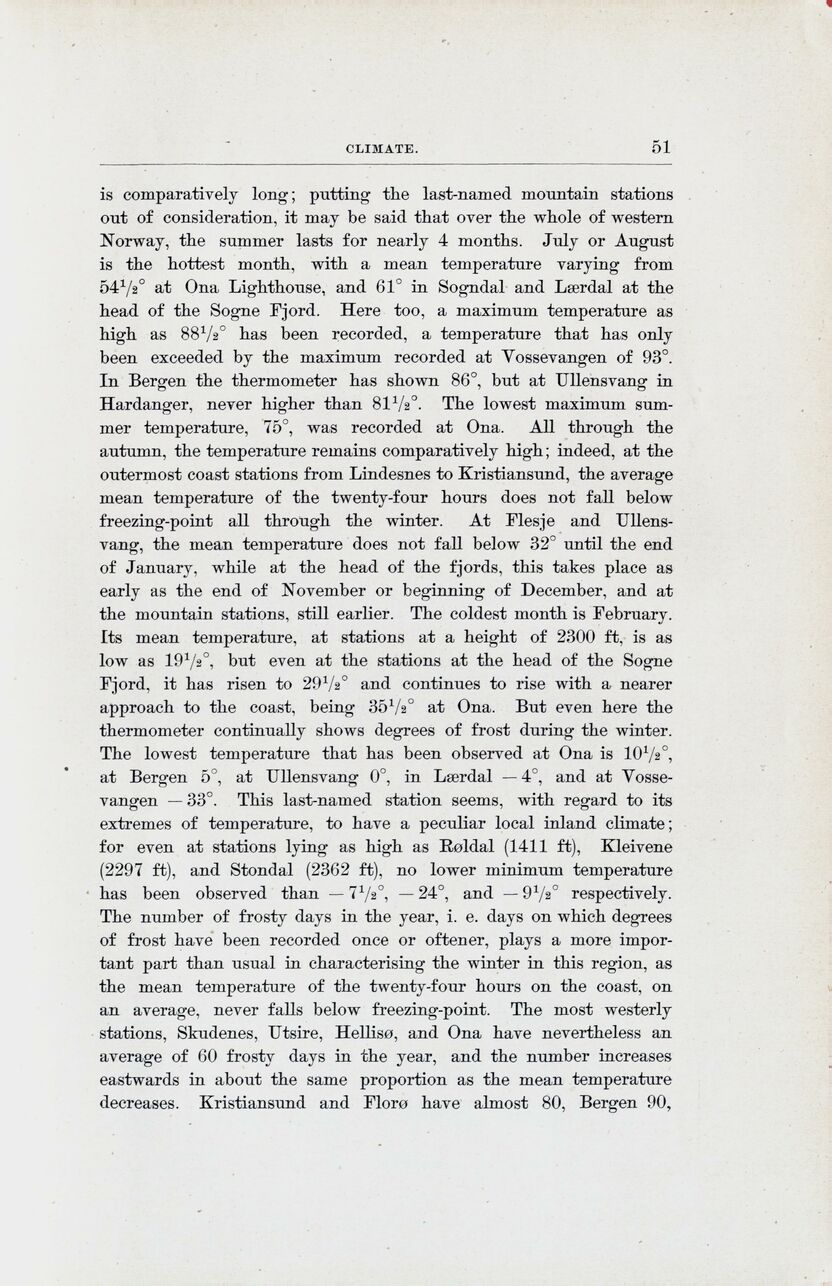
Full resolution (JPEG) - On this page / på denna sida - Climate, by Axel Steen

<< prev. page << föreg. sida << >> nästa sida >> next page >>
Below is the raw OCR text
from the above scanned image.
Do you see an error? Proofread the page now!
Här nedan syns maskintolkade texten från faksimilbilden ovan.
Ser du något fel? Korrekturläs sidan nu!
This page has been proofread at least once.
(diff)
(history)
Denna sida har korrekturlästs minst en gång.
(skillnad)
(historik)
is comparatively long; putting the last-named mountain stations
out of consideration, it may be said that over the whole of western
Norway, the summer lasts for nearly 4 months. July or August
is the hottest month, with a mean temperature varying from
54 ½° at Ona Lighthouse, and 61° in Sogndal and Lærdal at the
head of the Sogne Fjord. Here too, a maximum temperature as
high as 88 ½° has been recorded, a temperature that has only
been exceeded by the maximum recorded at Vossevangen of 93°.
In Bergen the thermometer has shown 86°, but at Ullensvang in
Hardanger, never higher than 81 ½°. The lowest maximum
summer temperature, 75°, was recorded at Ona. All through the
autumn, the temperature remains comparatively high; indeed, at the
outermost coast stations from Lindesnes to Kristiansund, the average
mean temperature of the twenty-four hours does not fall below
freezing-point all through the winter. At Flesje and
Ullensvang, the mean temperature does not fall below 32° until the end
of January, while at the head of the fjords, this takes place as
early as the end of November or beginning of December, and at
the mountain stations, still earlier. The coldest month is February.
Its mean temperature, at stations at a height of 2300 ft, is as
low as 19 ½°, but even at the stations at the head of the Sogne
Fjord, it has risen to 29 ½° and continues to rise with a nearer
approach to the coast, being 35 ½° at Ona. But even here the
thermometer continually shows degrees of frost during the winter.
The lowest temperature that has been observed at Ona is 10 ½°,
at Bergen 5°, at Ullensvang 0°, in Lærdal −4° , and at
Vossevangen −33°. This last-named station seems, with regard to its
extremes of temperature, to have a peculiar local inland climate;
for even at stations lying as high as Røldal (1411 ft), Kleivene
(2297 ft), and Stondal (2362 ft), no lower minimum temperature
has been observed than −7 ½°, −24°, and −9 ½° respectively.
The number of frosty days in the year, i. e. days on which degrees
of frost have been recorded once or oftener, plays a more
important part than usual in characterising the winter in this region, as
the mean temperature of the twenty-four hours on the coast, on
an average, never falls below freezing-point. The most westerly
stations, Skudenes, Utsire, Hellisø, and Ona have nevertheless an
average of 60 frosty days in the year, and the number increases
eastwards in about the same proportion as the mean temperature
decreases. Kristiansund and Florø have almost 80, Bergen 90,
<< prev. page << föreg. sida << >> nästa sida >> next page >>